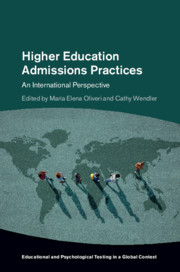Book contents
- Higher Education Admissions Practices
- Educational and Psychological Testing in a Global Context
- Higher Education Admissions Practices
- Copyright page
- Contents
- Figures
- Tables
- Contributors
- Series Editor’s Foreword
- Foreword
- Acknowledgments
- Part I Global Challenges and Common Admissions Models
- Chapter 1 An Overview of Higher Education Admissions Processes
- Chapter 2 Comparing College Aspirations across PISA Countries: Are 17 Percent Oranges Less than 75 Percent Apples?
- Chapter 3 Merit-Based Admissions in Higher Education
- Chapter 4 The Open Admissions Model: An Example from the United States
- Chapter 5 Character-Based Admissions Criteria in the United States and in Europe: Rationale, Evidence, and Some Critical Remarks
- Chapter 6 Cross-Cultural and Global Competencies and Their Role in Admissions Policies and Practices
- Part II Country-Specific Admissions Practices
- Part III Assessments Used in Higher Education Admissions
- Part IV Rethinking Higher Education Admissions
- Index
- References
Chapter 6 - Cross-Cultural and Global Competencies and Their Role in Admissions Policies and Practices
from Part I - Global Challenges and Common Admissions Models
Published online by Cambridge University Press: 09 January 2020
- Higher Education Admissions Practices
- Educational and Psychological Testing in a Global Context
- Higher Education Admissions Practices
- Copyright page
- Contents
- Figures
- Tables
- Contributors
- Series Editor’s Foreword
- Foreword
- Acknowledgments
- Part I Global Challenges and Common Admissions Models
- Chapter 1 An Overview of Higher Education Admissions Processes
- Chapter 2 Comparing College Aspirations across PISA Countries: Are 17 Percent Oranges Less than 75 Percent Apples?
- Chapter 3 Merit-Based Admissions in Higher Education
- Chapter 4 The Open Admissions Model: An Example from the United States
- Chapter 5 Character-Based Admissions Criteria in the United States and in Europe: Rationale, Evidence, and Some Critical Remarks
- Chapter 6 Cross-Cultural and Global Competencies and Their Role in Admissions Policies and Practices
- Part II Country-Specific Admissions Practices
- Part III Assessments Used in Higher Education Admissions
- Part IV Rethinking Higher Education Admissions
- Index
- References
Summary
Equity, diversity, and inclusion are key strengths of higher education institutions and are fundamental to achieving excellence in learning, teaching, and research. This chapter focuses on cross-cultural and global competencies and how they contribute to a more inclusive and diverse campus. The chapter provides a discussion of Indigenous Canadian students and how culturally inclusive approaches to admissions contributes to decolonizing practices in higher education. It also provides a summary on the significant growth and demand of international student mobility to Canadian universities, the need for Canadian students to gain cross-culturalcompetence by studying abroad, and the policies and practices that could be used to emphasize cross-cultural and global competencies for learners.
Keywords
- Type
- Chapter
- Information
- Higher Education Admissions PracticesAn International Perspective, pp. 96 - 118Publisher: Cambridge University PressPrint publication year: 2020
References
- 1
- Cited by



